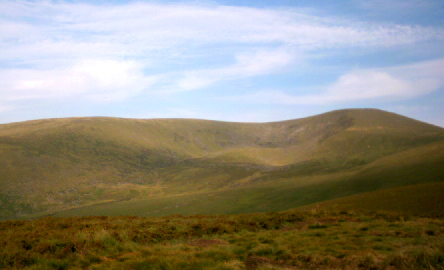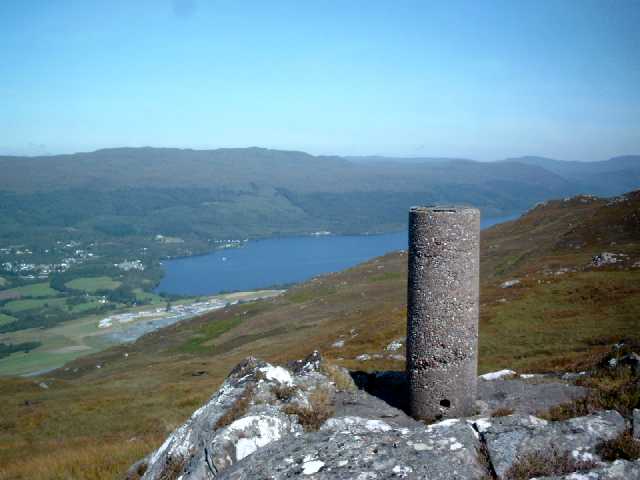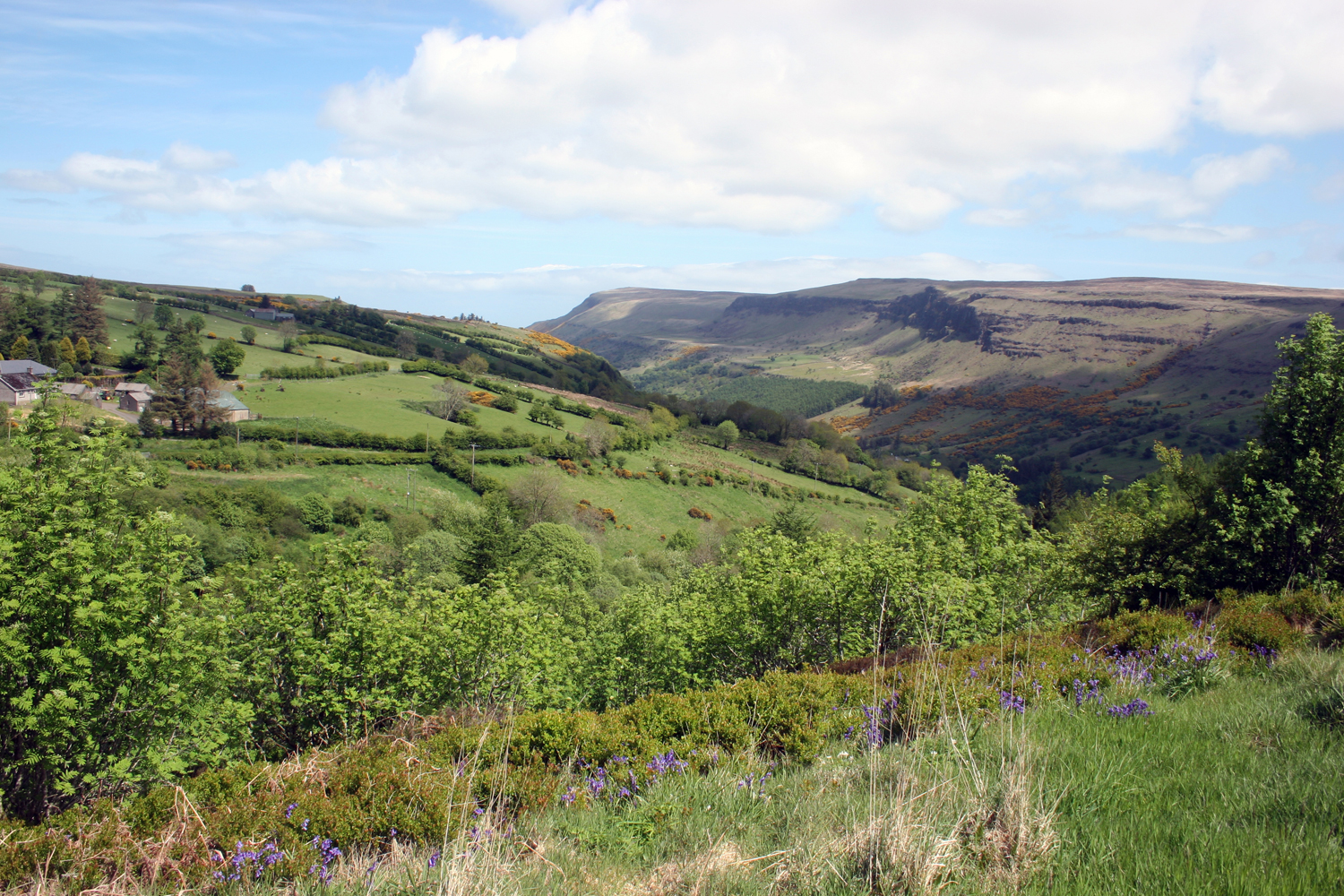|
Glen
A glen is a valley, typically one that is long and bounded by gently sloped concave sides, unlike a ravine, which is deep and bounded by steep slopes. Whittow defines it as a "Scottish term for a deep valley in the Highlands" that is "narrower than a strath".. The word is Goidelic in origin: ''gleann'' in Irish and Scottish Gaelic, ''glion'' in Manx. The designation "glen" also occurs often in place names. Etymology The word is Goidelic in origin: ''gleann'' in Irish and Scottish Gaelic, ''glion'' in Manx. In Manx, ''glan'' is also to be found meaning glen. It is cognate with Welsh ''glyn''. Examples in Northern England, such as Glenridding, Westmorland, or Glendue, near Haltwhistle, Northumberland, are thought to derive from the aforementioned Cumbric cognate, or another Brythonic equivalent. This likely underlies some examples in Southern Scotland. As the name of a river, it is thought to derive from the Irish word ''glan'' meaning clean, or the Welsh word ''gleindid' ... [...More Info...] [...Related Items...] OR: [Wikipedia] [Google] [Baidu] |
Glendale, California
Glendale is a city in the San Fernando Valley and Verdugo Mountains regions of Los Angeles County, California, Los Angeles County, California, United States. At the 2020 United States Census, 2020 U.S. Census the population was 196,543, up from 191,719 at the 2010 United States Census, 2010 census, making it the fourth-largest city in Los Angeles County and the List of largest California cities by population, 24th-largest city in California. It is located about north of downtown Los Angeles. Glendale lies in the Verdugo Mountains, and is a suburb in the Los Angeles metropolitan area. The city is bordered to the northwest by the Sun Valley, Los Angeles, Sun Valley and Tujunga, Los Angeles, California, Tujunga neighborhoods of Los Angeles; to the northeast by La Cañada Flintridge, California, La Cañada Flintridge and the unincorporated area of La Crescenta, California, La Crescenta; to the west by Burbank, California, Burbank and Griffith Park; to the east by Eagle Rock, Los An ... [...More Info...] [...Related Items...] OR: [Wikipedia] [Google] [Baidu] |
Glenrothes
Glenrothes (; , ; sco, Glenrothes; gd, Gleann Rathais) is a town situated in the heart of Fife, in east-central Scotland. It is about north of Edinburgh and south of Dundee. The town had a population of 39,277 in the 2011 census, making it the third largest settlement in Fife and the 18th most populous settlement in Scotland. The name Glenrothes comes from its historical link with the Earl of Rothes, who owned much of the land on which the new town has been built; ''Glen'' (Scottish for valley) was added to the name to avoid confusion with Rothes in Moray and in recognition that the town lies in a river valley. The motto of Glenrothes is , meaning "From the earth strength", which dates back to the founding of the town. Planned in the late 1940s as one of Scotland's first post-second world war new towns, its original purpose was to house miners who were to work at a newly established coal mine, the Rothes Colliery. After the mine closed, the town developed as an importa ... [...More Info...] [...Related Items...] OR: [Wikipedia] [Google] [Baidu] |
Glen Of Imaal
The Glen of Imaal ( or ; ga, Gleann Uí Mháil) is a remote glen in the western Wicklow Mountains in Ireland. It is ringed by the Lugnaquilla massif and its foothills, including Table Mountain and Keadeen. Much of the glen is used by the Irish Army as an artillery firing range, and hill walkers who use the glen are advised to observe the times of firing practice and to refrain from picking up strange objects. The Glen of Imaal is the subject of an eponymously titled Irish folk song, and also the place of origin of the eponymous dog breed, the Glen of Imaal Terrier. History Early history The Glen of Imaal is named from the Uí Máil, who dominated the kingship of Leinster in the 7th century. They were ousted by the Uí Dúnlainge from the lowlands of what would be County Kildare, and from that time until the early 13th century were located along the western foothills of the Wicklow mountains. The valley appears to have been a center of their power. By the 14th century, O'Tu ... [...More Info...] [...Related Items...] OR: [Wikipedia] [Google] [Baidu] |
Glenswilly GAA
Glenswilly GAA (Irish: ''CLG Gleann tSúilí'') is a GAA club based in Glenswilly, County Donegal, Ireland. Most noted for winning the Donegal Senior Football Championship in 2011, 2013 and 2016, the team has fielded players like All-Ireland winning captain Michael Murphy. The club's chairman is Michael Murphy. History The present club was founded in 1982. A teenage Manus McFadden arranged a meeting at Foxhall of Glenswillyites who were interested in forming a team, with Joe Kelly, Roger McDaid, Fr Eamon Crossan, Finbar Glackin, Jimmy Joe McGinley and chair Eddie McDevitt (who has since died). Glenswilly reached their first ever Senior County Final in 2007, where they lost to near neighbours St Eunan's 0–12 to 1–3. In 2011, they won the Donegal Senior Football Championship for the first time, with a 1–8 to 0–9 defeat of Naomh Mícheál in the final. On 25 September 2012, the Donegal senior team—fresh from winning the 2012 All-Ireland Senior Football Championship ... [...More Info...] [...Related Items...] OR: [Wikipedia] [Google] [Baidu] |
Great Glen
The Great Glen ( gd, An Gleann Mòr ), also known as Glen Albyn (from the Gaelic "Glen of Scotland" ) or Glen More (from the Gaelic ), is a glen in Scotland running for from Inverness on the edge of Moray Firth, in an approximately straight line to Fort William at the head of Loch Linnhe. It follows a geological fault known as the Great Glen Fault, and bisects the Scottish Highlands into the Grampian Mountains to the southeast and the Northwest Highlands to the northwest. The glen is a natural travelling route in the Highlands of Scotland, which is used by both the Caledonian Canal and the A82 road, which link the city of Inverness on the northeast coast with Fort William on the west coast. The Invergarry and Fort Augustus Railway was built in 1896 from the southern end of the glen to the southern end of Loch Ness, but was never extended to Inverness. The railway closed in 1947. In 2002, the Great Glen Way was opened. A long-distance route for cyclists, canoeists, and w ... [...More Info...] [...Related Items...] OR: [Wikipedia] [Google] [Baidu] |
Glendalough
Glendalough (; ) is a glacial valley in County Wicklow, Ireland, renowned for an Early Medieval monastic settlement founded in the 6th century by St Kevin. From 1825 to 1957, the head of the Glendalough Valley was the site of a galena lead mine. Glendalough is also a recreational area for picnics, for walking along networks of maintained trails of varying difficulty, and also for rock-climbing. History Kevin, a descendant of one of the ruling families in Leinster, studied as a boy under the care of three holy men: Eoghan, Lochan and Eanna. During this time, he went to Glendalough. He was to return later, with a small group of monks to found a monastery where the 'two rivers form a confluence'. Kevin's writings discuss his fighting "knights" at Glendalough; scholars today believe this refers to his process of self-examination and his personal temptations. His fame as a holy man spread and he attracted numerous followers. He died in about 618, traditionally on 3 June. For the nex ... [...More Info...] [...Related Items...] OR: [Wikipedia] [Google] [Baidu] |
Glen Norman, Ontario
A glen is a valley, typically one that is long and bounded by gently sloped concave sides, unlike a ravine, which is deep and bounded by steep slopes. Whittow defines it as a "Scottish term for a deep valley in the Highlands" that is "narrower than a strath".. The word is Goidelic in origin: ''gleann'' in Irish and Scottish Gaelic, ''glion'' in Manx. The designation "glen" also occurs often in place names. Etymology The word is Goidelic in origin: ''gleann'' in Irish and Scottish Gaelic, ''glion'' in Manx. In Manx, ''glan'' is also to be found meaning glen. It is cognate with Welsh ''glyn''. Examples in Northern England, such as Glenridding, Westmorland, or Glendue, near Haltwhistle, Northumberland, are thought to derive from the aforementioned Cumbric cognate, or another Brythonic equivalent. This likely underlies some examples in Southern Scotland. As the name of a river, it is thought to derive from the Irish word ''glan'' meaning clean, or the Welsh word ''gleindid' ... [...More Info...] [...Related Items...] OR: [Wikipedia] [Google] [Baidu] |
Glens Of Antrim
The Glens of Antrim,Logainm.ie () known locally as simply The Glens, is a region of , . It comprises nine glens (valleys), that radiate from the Antrim Plateau to the coast. The Glens are an |
Glenridding
Glenridding is a village at the southern end of Ullswater, in the English Lake District. The village is popular with mountain walkers who can scale England's third-highest mountain, Helvellyn, and many other challenging peaks from there. Etymology The name Glenridding is generally agreed to be Cumbric in origin, with the first element being ''*glinn'', 'valley', and the second being ''*redïn'', 'ferns, bracken' (cf. Welsh ''glyn rhedyn''), giving a meaning of 'valley overgrown with bracken'. First recorded as ''Glenredyn'' in around 1290, the name's present form is thought to have been influenced by the Middle English element ''ridding'', 'clearing'. Geography Glenridding is in the civil parish of Patterdale. On 6 December 2015, Storm Desmond caused extensive and devastating flooding to the village, with torrential rainfall and rivers bursting their banks. Four days later, more rainfall caused rivers to burst their banks once again, leading to even more flood damage to bu ... [...More Info...] [...Related Items...] OR: [Wikipedia] [Google] [Baidu] |
Glen Ellen
Glen Ellen is a census-designated place (CDP) in Sonoma Valley, Sonoma County, California, United States. The population was 784 at the 2010 census, down from 992 at the 2000 census. Glen Ellen is the location of Jack London State Historic Park (including the Wolf House), Sonoma Valley Regional Park, and a former home of Hunter S. Thompson. The whole of Glen Ellen was severely damaged by the Nuns Fire during the October 2017 Northern California wildfires. History In 1859, Charles V. Stuart purchased a part of the Rancho Agua Caliente land grant and in 1868 began building a house there, eventually establishing a vineyard he named Glen Ellen after his wife. The town that grew up around the vineyard also came to be called Glen Ellen, and Stuart's home was later renamed Glen Oaks Ranch. In October 2017, the area was badly affected by wildfire. Geography Glen Ellen is about northwest of the city of Sonoma. The United States Census Bureau fixes the total area at , 99.95% o ... [...More Info...] [...Related Items...] OR: [Wikipedia] [Google] [Baidu] |
Valley
A valley is an elongated low area often running between Hill, hills or Mountain, mountains, which will typically contain a river or stream running from one end to the other. Most valleys are formed by erosion of the land surface by rivers or streams over a very long period. Some valleys are formed through erosion by glacier, glacial ice. These glaciers may remain present in valleys in high mountains or polar areas. At lower latitudes and altitudes, these glaciation, glacially formed valleys may have been created or enlarged during ice ages but now are ice-free and occupied by streams or rivers. In desert areas, valleys may be entirely dry or carry a watercourse only rarely. In karst, areas of limestone bedrock, dry valleys may also result from drainage now taking place cave, underground rather than at the surface. Rift valleys arise principally from tectonics, earth movements, rather than erosion. Many different types of valleys are described by geographers, using terms th ... [...More Info...] [...Related Items...] OR: [Wikipedia] [Google] [Baidu] |
Larne
Larne (, , the name of a Gaelic Ireland, Gaelic territory) is a town on the east coast of County Antrim, Northern Ireland, with a population of 18,755 at the United Kingdom census, 2011, 2011 Census. It is a major passenger and freight Roll-on/roll-off, roll-on roll-off port. Larne is administered by Mid and East Antrim Borough Council. Together with parts of the neighbouring districts of Antrim and Newtownabbey Borough Council, Antrim and Newtownabbey and Causeway Coast and Glens Borough Council, Causeway Coast and Glens, it forms the East Antrim (UK Parliament constituency), East Antrim constituency for elections to the Westminster Parliament and Northern Ireland Assembly. The civil parish is in the historic Barony (geographic), barony of Glenarm Upper. History The coastal area around Larne has been inhabited for millennia, and is thought to have been one of the earliest inhabited areas of Ireland, with these early human populations believed to have arrived from Scotland via th ... [...More Info...] [...Related Items...] OR: [Wikipedia] [Google] [Baidu] |






.jpg)
.jpg)